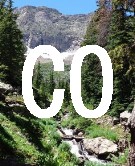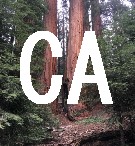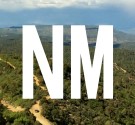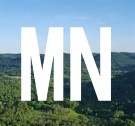|
Who
stacks heavy boulders?
If you can direct us to some previously documented, ancient
or modern human activity, that involved arranging 100+ pound
boulders like this ... please let us know.
These boulder stacks are found in a few uninhabited parts
of the Mescalero IR. In some places they are found in clusters
-- several stacks built near each other.
Similar stacks are found in the Pacific Northwest.
For some time it was thought they might be associated with
sasquatches, because sightings often occur in areas where
stacks are found.
One sighting from the Northwest drew a direct connection:
A sasquatch was seen tearing apart a boulder stack and catching
ground squirrels hiding among the gaps. The story made some
wonder if the stacks were put together for that purpose
-- to attract ground squirrels, which make nests in gaps
among boulders.
If you stack up some heavy boulders in a forest, and you
use the gaps between the boulders to form some natural looking
small chambers, and you leave that stack alone for some
time, ground squirrels will eventually make a nest inside,
or simply learn to hide there. It's pretty reliable, if
there are ground squirrels in that ecosystem.
Gaps among boulders are prefered by many types of small
mammals because they are usually impenetrable to four-legged
predators.
If the boulders are big, but not too big, and they're stacked
just right, and there are squirrels hiding or nesting inside,
you can easily run up and crush at least some of the squirrels
instantly by letting the roof collapse onto the nest chamber.
Squished squirrels don't run away.
If you like to gobble squirrels, but you don't like to chase
them, this is one nicely efficient, low-energy way to harvest
them.
The constructor only needs to create the boulder stack once,
then collapse it and reassemble it as necessary.
There could be alternate explanations for these mysterious
boulder stacks, but we can eliminate a few for this stack
on the Mescalero IR:
1) It's not a natural formation.
The boulders are different types of rock, carried from different
places. They were undoubtedly arranged by something(s) with
arms and hands, and we could barely lift some of the boulders.
2) It's not a grave.
Although it's hard to see in the photo, the stack was placed
on a solid rock outcropping that skims the surface there.
There's no way to make a grave there. It's solid granite.
The boulders are stacked on a protrusion of this solid rock
surface.
Placing it on solid rock allows it be to disassembled to
the floor so nothing can get away through tunnels in the
dirt.
3) It's not a hiker cairn or monument.
Hikers will sometimes stack up rocks (not boulders) at the
peaks of mountains, and sometimes at junctions along trails.
The purpose is to create a monument or landmark at that
spot for others to notice.
There would have been no need to find and carry 100+ pound
boulders to this spot in order to make a stack that would
have been noticeable to passersby. It would be much quicker
and easier to make an adequately sturdy monument with football-size
stones.
There are no non-tribal hikers coming onto the reservation
anyway. Tribal members do go hiking, especially in Spring,
when they are looking for shed elk antlers, but they don't
need monuments or cairns to mark their trails. They know
where they are going.
4) It's not a boundary marker for an old homestead.
It's deep in the heart of the Apache stronghold, not far
from a main route to the main village. No white settlers
or homesteaders ever tried to settle here. The area has
been inhabited and defended by Apaches since long before
Columbus. There was no period in history when the native
population had been moved out and temporarily replaced by
white settlers. That happened in some other parts of the
country, but not here.
Like most other native populations, Apaches did not sub-divide
their own land. Their land was communally owned and communally
utilized (and still is for the most part). The partitioning
of some parcels for homes for tribal members is a recent
practice.
Locals said the land around this boulder stack has never
been assigned as a parcel to a tribal member. Its status
has remained unchanged throughout history. It was always
communal, tribal hunting grounds.
The historical continuity of the location eliminates the
possibility that someone would have put a property boundary
marker here at any time in the past.
5) It wasn't made by the Apaches.
We asked many tribal members if they knew the origin and
purpose of these boulders stacks. No one could connect them
to a native practice, ancient or modern.
Some who sought answers from elders in the past were told
that they were not connected with the ancient indian tribes
(Anasazi), or the Apaches. There was no explanation offered
for their origin, but at least a few grandparents said the
stacks should be avoided and not touched.
Cultural memory extends back a long way here. If there were
any practical, useful purposes for stacking boulders like
this, those purposes would not have been completely forgotten.
Tribal members occassionally stumble across boulder stacks
and ask about them among other tribal members. The recurring
questions about them would have kept the story going, if
there was one. Had the stacks been connected to humans there
would have been an explanation, or at least a story, or
a legend, about their use or significance.
Some areas on the reservation where large rocks were moved
and arranged for ancient symbolic or ceremonial purposes,
are distinctly different from these simple boulder stacks.
The Anasazi rock arrangements are more elaborate, and they
are never in isolation.
If there's any ceremonial rock arrangments at all, the ground
is always made flat and apparently prepared for a crowd,
or a least a decent size encampment. Tribal members know
what those look like.
During the Mescalero expedition we heard about this one
accessible boulder stack and wanted to photograph it. We
were also curious to see if it had cavities wherein rodents
had made a nest.
We didn't know if there were any squirrels inside as we
took it apart. We had to be careful as we disassembled it,
so as not to squish anything that might be in there.
Inside there was indeed a pocket filled with the bedding
for either ground squirrels or chipmunks. Nuts and small
pine cones were also stored inside by the rodents.
No rodents were inside at the time.
We wanted to see more of these stacks, but the other areas
where people said we'd find more were inaccessible due to
weather-affected road conditions (snow and mud).
Keep an eye peeled for stacks of boulders, and please photograph
them and GPS them if you find some.
We'll be looking for more on upcoming expeditions.
|



















